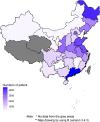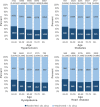Risk factors associated with 31-day unplanned readmission in 50,912 discharged patients after stroke in China
- PMID: 30587162
- PMCID: PMC6306006
- DOI: 10.1186/s12883-018-1209-y
Risk factors associated with 31-day unplanned readmission in 50,912 discharged patients after stroke in China
Abstract
Background: Unplanned readmission within 31 days of discharge after stroke is a useful indicator for monitoring quality of hospital care. We evaluated the risk factors associated with 31-day unplanned readmission of stroke patients in China.
Methods: We identified 50,912 patients from 375 hospitals in 29 provinces, municipalities or autonomous districts across China who experienced an unplanned readmission after stroke between 2015 and 2016, and extracted data from the inpatients' cover sheet data from the Medical Record Monitoring Database. Patients were grouped into readmission within 31 days or beyond for analysis. Chi-squared test was used to analyze demographic information, health system and clinical process-related factors according to the data type. Multilevel logistic modeling was used to examine the effects of patient (level 1) and hospital (level 2) characteristics on an unplanned readmission ≤31 days.
Results: Among 50,912 patients, 14,664 (28.8%) were readmitted within 31 days after discharge. The commonest cause of readmissions were recurrent stroke (34.8%), hypertension (22.94%), cardio/cerebrovascular disease (13.26%) and diabetes/diabetic complications (7.34%). Higher risks of unplanned readmissions were associated with diabetes (OR = 1.089, P = 0.001), use of clinical pathways (OR = 1.174, P < 0.001), and being discharged without doctor's advice (OR = 1.485, P < 0.001). Lower risks were associated with basic medical insurances (OR ranging from 0.225 to 0.716, P < 0.001) and commercial medical insurance (OR = 0.636, P = 0.021), compared to self-paying for medical services. And patients aged 50 years old and above (OR ranging from 0.650 to 0.985, P < 0.05), with haemorrhagic stroke (OR = 0.467, P < 0.001), with length of stay more than 7 days in hospital (OR ranging from 0.082 to 0.566, P < 0.001), also had lower risks.
Conclusions: Age, type of stroke, medical insurance status, type of discharge, use of clinical pathways, length of hospital stay and comorbidities were the most influential factors for readmission within 31 days.
Keywords: Cover sheet of medical record; Hospitalization; Risk factor; Stroke; Unplanned readmission.
Conflict of interest statement
Ethics approval and consent to participate
The ethics committees at Institute of Basic Research in Clinical Medicine at China Academy of Chinese Medical Sciences approved this study (Reference number: 2016NO.11–01) on November 7, 2016. The China Academy of Chinese Medical Sciences granted administrative permission to access the raw data from the Medical Record Monitoring Database.
Consent for publication
Not applicable.
Competing interests
The authors declare that they have no competing interests.
Publisher’s Note
Springer Nature remains neutral with regard to jurisdictional claims in published maps and institutional affiliations.
Figures




Similar articles
-
Factors associated with unplanned readmissions within 1 day of acute care discharge: a retrospective cohort study.BMC Health Serv Res. 2018 Sep 14;18(1):713. doi: 10.1186/s12913-018-3527-6. BMC Health Serv Res. 2018. PMID: 30217155 Free PMC article.
-
Factors Associated With 90-Day Readmission After Stroke or Transient Ischemic Attack: Linked Data From the Australian Stroke Clinical Registry.Stroke. 2020 Feb;51(2):571-578. doi: 10.1161/STROKEAHA.119.026133. Epub 2019 Dec 11. Stroke. 2020. PMID: 31822248
-
Factors associated with unplanned readmissions in a major Australian health service.Aust Health Rev. 2019 Feb;43(1):1-9. doi: 10.1071/AH16287. Aust Health Rev. 2019. PMID: 29092726
-
Risk factors for unplanned 31-day readmission after surgery for colorectal cancer patients: a meta-analysis.BMC Gastroenterol. 2025 Apr 23;25(1):285. doi: 10.1186/s12876-025-03872-5. BMC Gastroenterol. 2025. PMID: 40269754 Free PMC article.
-
Risk factors associated with paediatric unplanned hospital readmissions: a systematic review.BMJ Open. 2019 Jan 28;9(1):e020554. doi: 10.1136/bmjopen-2017-020554. BMJ Open. 2019. PMID: 30696664 Free PMC article.
Cited by
-
Combined Functional Assessment for Predicting Clinical Outcomes in Stroke Patients After Post-acute Care: A Retrospective Multi-Center Cohort in Central Taiwan.Front Aging Neurosci. 2022 Jun 17;14:834273. doi: 10.3389/fnagi.2022.834273. eCollection 2022. Front Aging Neurosci. 2022. PMID: 35783145 Free PMC article.
-
Predicting 30-Day Readmission for Stroke Using Machine Learning Algorithms: A Prospective Cohort Study.Front Neurol. 2022 Jul 4;13:875491. doi: 10.3389/fneur.2022.875491. eCollection 2022. Front Neurol. 2022. PMID: 35860493 Free PMC article.
-
Risk of Mortality After an Arterial Ischemic Event Among Intracerebral Hemorrhage Survivors.Neurohospitalist. 2022 Jan;12(1):19-23. doi: 10.1177/19418744211026709. Epub 2021 Jun 25. Neurohospitalist. 2022. PMID: 34950382 Free PMC article.
-
Validating World Health Organization cardiovascular disease risk charts and optimizing risk assessment in China.Lancet Reg Health West Pac. 2021 Feb 5;8:100096. doi: 10.1016/j.lanwpc.2021.100096. eCollection 2021 Mar. Lancet Reg Health West Pac. 2021. PMID: 34327424 Free PMC article.
-
Patient Readmission for Ischemic Stroke: Risk Factors and Impact on Mortality.Inquiry. 2024 Jan-Dec;61:469580241241271. doi: 10.1177/00469580241241271. Inquiry. 2024. PMID: 38529892 Free PMC article.
References
-
- Chen WW, Gao RL, Liu LS, Zhu ML, Wang W, Wang YJ, et al. Synopsis of the report on cardiovascular diseases in China (2017) Chin Circulation J. 2018;33(1):1–8.
-
- Information Office of Ministry of Health of China Report on the third National Survey of death causes. China Cancer. 2008;17(5):344–345.
-
- Ma Y, Xiong XJ, Li JH, Fang YY. Effect of health insurance on direct hospitalization costs for in-patients with ischemic stroke in China. Aust Health Rev. 2017. 10.1071/AH16056. - PubMed
-
- National Health and Family Planning Commission of China China health and family planning statistics yearbook. Peking Union Medical College Press. 2016;2016:p113.
MeSH terms
Grants and funding
LinkOut - more resources
Full Text Sources
Medical

